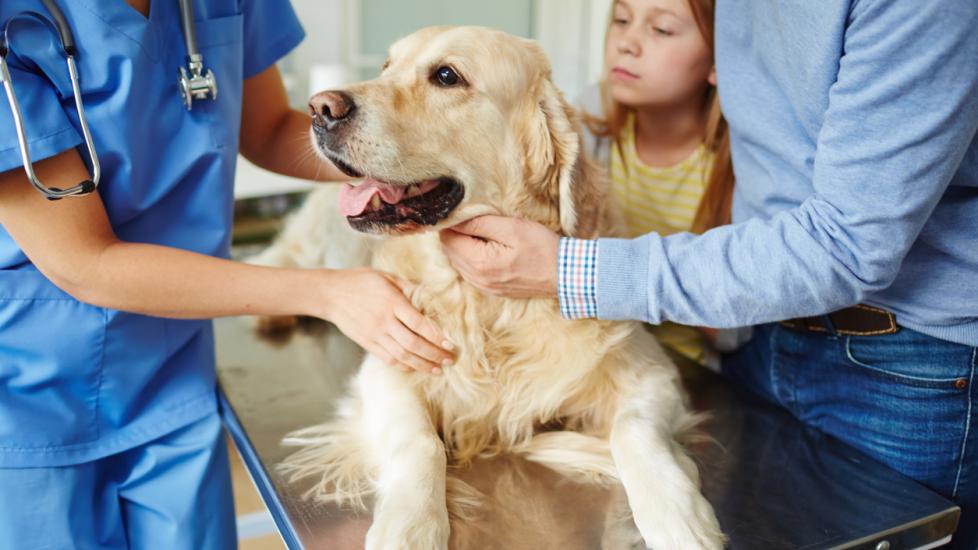Thyroid Cancer in Dogs
What is Thyroid Cancer in Dogs?
In a dog’s neck, the two lobes of the thyroid gland lie on either side of the trachea. The gland is responsible for producing a thyroid hormone to help regulate the body’s metabolism. Tumors of the thyroid gland can be either benign (not cancerous) or malignant (cancerous).
Malignant thyroid tumors may affect one or both lobes of the thyroid, with the potential to spread to other places in the body. In some cases, dogs can have thyroid tissue elsewhere in the body. It’s called ectopic thyroid tissue, and this tissue is also at risk of developing cancer. Ectopic thyroid tissue is rare, but most commonly found at the base of the tongue.
Thyroid cancer is locally invasive, meaning it can grow bigger in one area, but also has the potential for metastasis, or spreading to other organs. The most common places for thyroid invasion locally include the trachea and the esophagus. For systemic spread (metastasis), the lymph nodes are most common, followed by the lungs. These tumors have usually already spread at the time of a diagnosis.
Benign thyroid tumors, called adenomas, will not spread or have a long-term impact on your dog’s health. However, these tumors as uncommon, as about 90 percent of thyroid tumors in dogs are malignant. Malignant (cancerous) thyroid tumors are called carcinomas, meaning these are a type of tumor originating from epithelial tissue, in this case the thyroid gland.
Symptoms of Thyroid Cancer in Dogs
Many dogs with thyroid cancer may not have any symptoms at all. In most cases, the mass can be felt by running your hands down the underside of the neck. In later stages, the thyroid tumor may start to invade local tissue, such as the trachea, which could lead to coughing, exercise intolerance, and changes in respirations. If the esophagus is similarly affected, common symptoms include hard swallowing or trouble eating.
More nonspecific symptoms seen in dogs with thyroid cancer include:
-
Weight loss
-
Decreased appetite
-
Changes in bark
-
Lethargy
Causes of Thyroid Cancer in Dogs
In dogs, as in humans, there is not much known about why a certain tumor develops. It is thought to be a multifactorial process influenced by several different things, including:
-
Breed
-
Sex
-
Genetic links or family traits
-
Environment
There are certain breeds that are overrepresented in thyroid cancer diagnoses, including:
-
Golden Retrievers
-
Beagles
-
Boxers
-
Huskies
How Veterinarians Diagnose Thyroid Cancer in Dogs
Diagnosis of thyroid cancer starts the same as for most other disease processes—a full body workup. Your veterinarian may recommend the following non-invasive tests for diagnosis.
-
A physical exam, in which a mass can be felt
-
Blood work to look for changes in white cell counts or organ function
-
Chest X-rays to evaluate for metastasis or spread of disease
-
Ultrasound of the neck, which can show the size of the tumor and may be helpful to evaluate the size of the lymph nodes in the neck
In dogs, once a thyroid tumor is suspected, a CT or MRI may be ordered prior to surgery to evaluate for any spread of disease. CT scans and MRIs are anesthetic procedures and may take several hours and advance planning to accomplish. For a definitive diagnosis, a surgical biopsy would be needed.
Treatment of Thyroid Cancer in Dogs
As with most cancers, there are a variety of treatment options depending on the type and spread of the tumor. Routine options for management of canine thyroid cancers include:
-
Surgery
-
Chemotherapy
-
Radiation
For dogs with thyroid tumors with minimal invasion to local tissues, surgery is typically recommended. This procedure is called a thyroidectomy, where the tumor is physically removed and sent to the lab for a biopsy to confirm the type of cancer (benign or malignant).
Depending on the amount of tumor that can be removed, follow-up with chemotherapy or radiation may be recommended. Radiation and chemotherapy are a multistep process and are performed at various time intervals for several weeks, depending on the type of chemotherapy and radiation used.
In dogs who are not good candidates for surgery, due to the extensive nature of the mass or other underlying diseases that put them at risk for anesthetic complications, radioactive iodine (I-131) is an option. It is injected into the patient and destroys active cancerous tissue. This is a common therapy in cats, but due to the large doses needed, may be prohibitive in dogs due to cost and availability.
Recovery and Management of Thyroid Cancer in Dogs
While there are risks with any anesthetic and surgical procedure, most dogs do well post-operatively after thyroidectomies and have no major complications. Recovery may require overnight monitoring in the hospital, with a next day discharge, in most cases.
Prognosis and life expectancy depend on the size and spread of the tumor. For thyroid tumors that are completely surgically removed, the median survival time can be upwards of two years. For tumors that require followup with chemotherapy and/or radiation, the prognosis is still good, with a median survival time ranging from 18 to 24 months. For dogs undergoing radiation and chemotherapy without surgical intervention, prognosis is poor, with an average survival time of between 6 and 12 months depending on the metastasis.
Thyroid Cancer in Dogs FAQs
How fast does thyroid cancer spread in dogs?
Thyroid cancer has a fast rate of spread, with about 35 percent of dogs already having metastasis at the time of diagnosis.
What is the life expectancy of a dog with thyroid cancer?
Depending on the type of treatments used, life expectancy can range from six months to two years.
References
Help us make PetMD better
Was this article helpful?
